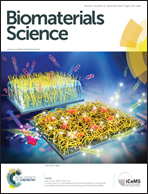Glucose-bearing biodegradable poly(amino acid) and poly(amino acid)-poly(ester) conjugates for controlled payload release†
Abstract
The glucoseamine-initiated ring-opening polymerisation of amino acid N-carboxyanhydrides and O-carboxanhydrides to yield amphiphilic block copolymers that are capable of self-assembly in aqueous solution to form well-defined, glucose-presenting, particles is reported. The particles formed are susceptible to enzyme-mediated (lipase and protease) and pH-induced degradation, and can selectively bind the lectin concanavalin A. Consequently, such glycoparticles are of significance for the controlled release of payload molecules in response to an acidic environment, for instance cancerous tissue, and upon interaction with target enzymes.


 Please wait while we load your content...
Please wait while we load your content...